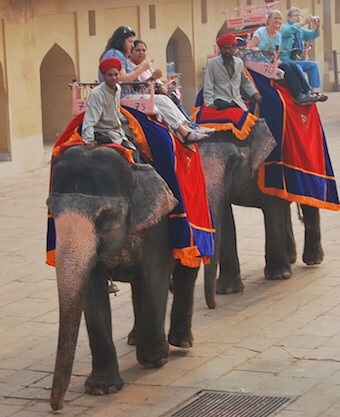By Tina Romenesko

Our first few days are focused on getting acclimated – to the time change (11 ½ hours for me; only India would run a country on the half hour), as well as food, the group schedule, and cultural nuances like begging children, rampant poverty, and the ubiquitous sacred cows wandering the city streets.
The Taj Mahal is our first stop outside of Delhi – and it is tremendous. The “Taj” is a UNESCO World Heritage site and also widely considered to be one of the most beautiful and perfect buildings ever constructed. While we are all prepared for this to be an amazing site, its ethereal splendor is beyond incredible. Our group photo – taken by a local hawker on a small instamatic – is a 5 X 7 treasure of a lifetime.
In Jaipur, we meet Jaimala, one of the founders of Vatsalya. Vatsalya has been TWR’s partner on the Anchal Project, a cooperative that provides careers in textiles to commercial sex workers. Vatsalya’s vision is broad and encompassing, working to progress Indian society by enabling disadvantaged people of all ages and persuasions to achieve their true potential. We are fortunate enough to spend most of the day sitting on the floor with the Anchal Project’s women participants during a workshop. One of the project directors, Colleen, a Rhode Island School of Design graduate, is teaching them new stitches and designs to fill an upcoming order with Urban Outfitters. The women’s work is beautiful, but it is the sense of community they share that is the most impressive. The vast majority of these women have decided to change professions, from prostitutes to seamstresses, to raise the status of their children and grandchildren, so they can attend better schools, and have opportunities none of them would have realized without the support of Vatsalya, Anchal and TWR.
After a quick stop at the famous Pushkar Camel Fair, we head for a small village about 3 hours west of Kolkata and the next phase of our trip. The projects here are administrated by the effervescent Ayesha Khatun, a young and highly educated Muslim woman from the village, who works in partnership with the Association for India’s Development, Inc. (AID). Some of the TWR funds support kitchen gardens that supply healthy food for community consumption. Other TWR-supported projects include vocational training in embroidery, poultry raising, the production of sanitary napkins, as well as legal and psychological support to over 3000 area women. Most of this population falls between the cracks, due to their low position in Indian society. This is a favorite stop for many of us – the hard work and community involvement is palpable, as are the struggles these families face on a daily basis.
The last project we visit is based in Ranchi, India. Matrichaya has received ongoing support from TWR since 2006. The heart of this project is Chanchala, the matriarch and director who has converted her ancestral home into a school for local children living in the slums. All education is done in English, and her daughters now help run programs focused on education, self-employment, and healthcare for under-privileged children and women in the area. We visit computer labs, beauty classes, and even a village that focuses on making products from local bamboo resources. The girls crowd around us, eager to practice their English and share their stories. The reach of these projects is impressive.
As the trip comes to a close, our group leader Taryn encourages each of us to share our reflections on the projects we have visited. Most of the projects had similar goals, yet each project was unique in its leadership, focus, and heart, which we found to be inspiring.
Back in Milwaukee, I express to my local chapter how proud I am to be part of this organization and that monthly participation really does make a difference for these women and families. As I tell them about the banners we saw in small villages, the plaques announcing gratitude to TWR, and how “Together Women Rise”, with a cute Hindi accent, is now a part of these women’s vocabulary, I feel my eyes fill with tears. The TWR trip to India was not an easy journey – in many many ways yet to be fully understood and realized – but I can see clearly that it was an important one.
Keep up the good work. Support the monthly projects. Spread the word that these grassroots efforts actually do change the world for these women and children. One Dinner at a Time.
View trip photos on Flickr Read trip diary
